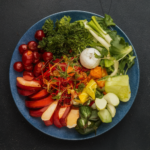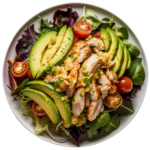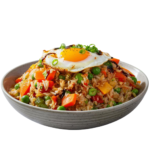The Ultimate Guide to Keto Meal Prep for Beginners
Introduction
Embarking on a ketogenic diet is more than just a change in eating habits; it is a transformative journey towards enhanced health and vitality. The ketogenic diet, often referred to as the keto diet, focuses on a low-carb, high-fat nutritional approach that aims to shift your body’s metabolism from carbohydrates to fats as its primary source of energy. For beginners, meal prepping on a keto diet can be both exciting and daunting. This comprehensive guide will walk you through every step of the process, ensuring that your transition to keto is seamless and sustainable.
Understanding the Keto Diet
What is the Keto Diet?
The keto diet is a high-fat, low-carbohydrate eating plan that has been praised for its potential health benefits, including weight loss, improved mental clarity, and increased energy levels. By drastically reducing carbohydrate intake and replacing it with fat, the body enters a state known as ketosis.
How Ketosis Works
In ketosis, the body becomes incredibly efficient at burning fat for energy. It also converts fat into ketones in the liver, which can supply energy for the brain. This metabolic state can lead to significant health improvements and weight loss.
The Importance of Meal Prep
Why Meal Prep is Crucial for Keto Success
Meal prepping ensures that you always have keto-friendly meals on hand, reducing the temptation to reach for non-keto options. It helps maintain portion control, saves time, and can be cost-effective. For beginners, having a plan can make the transition smoother and help establish lasting habits.
Benefits of Keto Meal Prep
- Consistency: Keeps your diet on track.
- Time-Saving: Reduces daily cooking time.
- Cost-Effective: Helps avoid unnecessary purchases.
- Portion Control: Ensures you eat the right amounts.
Getting Started with Keto Meal Prep
Assess Your Goals
Before diving into meal prepping, it’s essential to define your goals. Whether it’s weight loss, improved energy, or better mental clarity, having clear objectives can guide your meal planning.
Stocking Your Keto Pantry
A well-stocked pantry is the backbone of successful meal prep. Essential keto ingredients include:
- Healthy Fats: Avocado oil, olive oil, coconut oil, butter, ghee.
- Proteins: Eggs, chicken, beef, pork, fish, tofu.
- Low-Carb Vegetables: Spinach, kale, zucchini, cauliflower, broccoli.
- Dairy: Cheese, cream, Greek yogurt.
- Nuts and Seeds: Almonds, walnuts, chia seeds, flaxseeds.
Essential Kitchen Tools for Keto Meal Prep
Having the right tools can streamline your meal prep process. Consider investing in:
- Quality Knives: For chopping vegetables and proteins.
- Meal Prep Containers: For portion control and storage.
- Blender/Food Processor: For smoothies, sauces, and more.
- Instant Pot/Slow Cooker: For effortless cooking.
Creating Your Keto Meal Plan
Choosing the Right Recipes
Select recipes that align with your taste preferences and dietary needs. Look for dishes that are simple, quick to prepare, and use easily accessible ingredients.
Balancing Macros
Understanding macronutrients (macros) is crucial for keto success. Your diet should consist of approximately 70-75% fat, 20-25% protein, and 5-10% carbohydrates. Use apps or online tools to help calculate your macros and ensure your meals are balanced.
Sample Weekly Meal Plan
Day 1:
- Breakfast: Avocado and egg muffins
- Lunch: Grilled chicken salad with olive oil dressing
- Dinner: Salmon with asparagus and butter sauce
Day 2:
- Breakfast: Keto smoothie (spinach, avocado, almond milk)
- Lunch: Cauliflower rice stir-fry with beef
- Dinner: Pork chops with roasted Brussels sprouts
Meal Prep Strategies
Batch Cooking
Batch cooking involves preparing large quantities of food at once, which can be portioned out and stored for the week. This method is efficient and ensures you always have meals ready to go.
Using Leftovers Creatively
Repurposing leftovers can add variety to your meals and reduce waste. For example, leftover grilled chicken can be used in salads, wraps, or casseroles.
Storing Your Meals
Proper storage is essential to maintain the freshness and quality of your meals. Use airtight containers, and label them with dates to keep track of what needs to be consumed first.
Adapting Keto Meal Prep to Your Lifestyle
Keto Meal Prep for Busy Schedules
If you’re pressed for time, focus on quick and easy recipes that require minimal preparation. Smoothies, salads, and one-pan dishes are great options.
Family-Friendly Keto Meal Prep
Creating meals that the entire family will enjoy can simplify your meal prep. Focus on versatile dishes that can be adjusted to fit everyone’s preferences.
Traveling on Keto
When traveling, planning is key. Pack keto-friendly snacks, research restaurant menus in advance, and stay hydrated to stay on track.
Overcoming Common Challenges
Dealing with Keto Flu
The “keto flu” can occur as your body adapts to ketosis, causing symptoms like fatigue, headaches, and irritability. Stay hydrated, increase your salt intake, and get plenty of rest to alleviate these symptoms.
Handling Cravings
Cravings for high-carb foods can be challenging. Combat them by ensuring you’re eating enough fat and protein, staying hydrated, and keeping keto-friendly snacks on hand.
Maintaining Motivation
Staying motivated on a keto diet can be tough. Set realistic goals, track your progress, and reward yourself for milestones achieved.
Conclusion
Embarking on a keto journey requires commitment, but with the right meal prep strategies, you can achieve long-term success. By understanding the basics of the keto diet, stocking your pantry, planning your meals, and overcoming common challenges, you’ll be well on your way to a healthier, more vibrant life.











